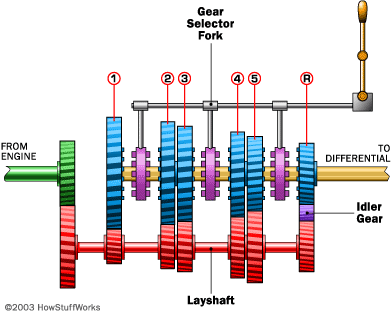Manual Transmission
Over the past year, I have gradually developed an avid interest in automobiles. Before that, my fascination with cars only extended to the aesthetics. However, after regularly racing go karts this summer and getting hooked on watching Formula 1, I have also come to appreciate the performance of vehicles. In order to understand these beautiful beasts, I am writing a series on the basics of an automobile in order to get an introductory understanding of the involved mechanics.
Jimmy learns stick
A few days ago, my friend Jimmy wanted to learn how to drive a manual car. I learned to drive stick since an early age, and I was confident that I could teach him how, or so I thought. I explained the theory of manual driving to Jimmy:
- Change gears while pressing the clutch
- As you let go of the clutch gradually, press the gas
- Repeat
Not possessing a manual car myself, we recruited another friend, Nick, to help teach Jimmy the ways of the manual gods. Not only did Nick help us with the car, but he also blew me away with his knowledge and instruction of how a manual car works. Unlike my ignorant teaching style, he delved into topics of torque, RPMs, gears and differentials. Humbled, I listened patiently and decided to do more research on how a car’s transmission works.
How gears work
In order to understand a car’s transmission, we need to know the basics behind gears. Gears are useful in transferring power by creating a mechanical advantage. This has a lot to do with rotational speed and torques. Let’s say we have two gears, Gear 1 and Gear 2, and their teeth are interlocked together. Gear 2 is twice as big as Gear 1. If we start rotating 1 at 10 RPMs, 2 will rotate at 5 RPMs. This is simply because Gear 2 is twice as big and it takes longer for it to go through one rotation at that particular rotational speed.
While Gear 2 is rotating at 5 RPMs, the torque applied on Gear 2 is higher, because the same amount of power is transferred from Gear 1 to Gear 2. Essentially, this means that the size difference between the two gears allows Gear 1 to exert more force on Gear 2 without having to work that much harder. Look here for a deeper explanation for the relationship between power and torque.
This is what leads us into car transmissions. When a car is stopped, the wheels are reluctant to move due to friction and Newton’s first law of motion. In order to get a car moving without damaging the engine, gears are used. Imagine that the rotating parts of the engine are Gear 1 and the wheels are connected to Gear 2. This allows the engine to transfer more force to the wheels and get them started. Now, once the car is in motion, we can switch to higher gears that can then harness the complete rotational speed of the drive shaft to go faster.
The gearbox

Now that we know the magic behind gears, let’s see how we actually go about changing them in the car. Let’s see what is happening in the picture above. The drive shaft is connected to the engine and is colored green. The gears themselves are labeled and colored blue. The yellow shaft is connected to the wheels. The red assembly is the layshaft which helps to change gears without having to move too many pieces around inside a car.
Notice that blue gears decrease in size and the red gears increase in size from left to right. This is to ensure the correct transfer of torque to the wheels. In 1st gear, we want more torque to get the car moving, hence the big blue gear and the small red gear. In 5th gear, we want to transfer all the RPMs from the engine to the wheels, hence the gears are both the same size.
In this setup, the blue gears are currently free, which means that if they rotate, the yellow shaft will not rotate with them. In order to make the yellow shaft rotate, the pink cogs are used to lock the blue gears on to the shaft. When you change gears in a car, you move the stick which in turn moves the corresponding pink cog and locks the appropriate blue gear in place.
The only thing missing from this picture is the clutch. The clutch is used to make sure that the engine is not damaged when changing gears. It utilized friction to ensure a smoother operation between the gearbox and the engine when changing gears. This video does a great job of explaining how the clutch works.
If you didn’t think I did a good job in explaining how the transmission in a car works, you can check out this video that does a great job and also uses some cool animations.